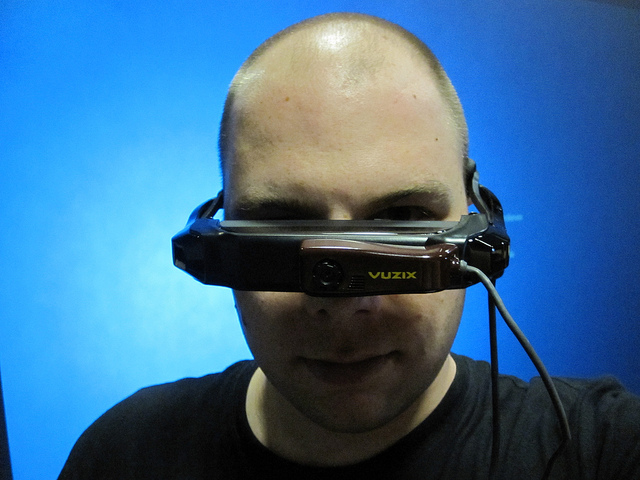Pictures of Google’s Sergey Brin spotted with the prototype of the Google Glass in a New York subway made headlines across the globe. Google’s project to create its own head mounted computer is probably the most know augmented reality (AR) project ever, however the use of AR technology is much broader and is beginning to be integrated into many different sectors, including journalism and the media. Researchers John V. Pavlik (Northwestern University in Qatar) and Frank Bridges (State University of New Jersey) have composed a monograph of their analysis in this field entirely dedicated to how AR is becoming a tool for storytelling in journalism.
According to Mashable, AR technology enhances the “live, direct or indirect, view of a physical, real-world environment whose elements are augmented by computer-generated sensory input such as sound, video, graphics or GPS data.” Since the early nineties, this technology has been used in a variety of different activities, including art, videogames and even aircraft construction. The monograph reports that Boeing was an early adopter of AR technology, using it to help engineers and builders “sort aircraft parts.” The recent miniaturization and commercialization of AR technology, in particular via apps for mobile devices, has opened the way for “media organizations that began to adopt and utilize AR technologies for journalism and strategic communication purposes,” write Pavlik and Bridges. The BBC, the New York Times, USA Today, the Wall Street Journal, the Boston Globe and the Financial Times were the first media outlets to experiment with AR. By using Aurasma, an image recognition app, for example, the Times and the Journal were able to integrate mobile digital media with their print content, “by pointing an iPhone or iPad at a newspaper article with a photograph of presidential candidate Mitt Romney, for example, video of a speech by Romney could begin playing in the mobile device synchronized over the newspaper photo”, the researchers explain.
These new possibilities facilitate different approaches to storytelling in digital media and could inspire new and innovative ways to read the news. According to the authors, “AR is poised to transform the storytelling of twenty-first century journalism in perhaps the same fashion as photography of 150 years before.” But how? Pavlik and Bridges cite the “situated documentary” (an experiment on which was conducted by Columbia University in 1996), a form of immersive storytelling where users wear a head-worn display while walking through a location of historical importance. Through GPS and geotagging, multimedia content related to the site appears on the display as the users walk around, it’s something in between a 3D documentary and a museum tour which gives users the chance to interact with the surrounding environment from a first-person perspective. Other companies are now working on similar wearable products, alongside Google Glass, for which the New York Times launched its app, is Vuzik who are launching another video display glasses-like device much talked about at the latest Mobile World Congress in Barcelona.
 QR codes, on the other hand, have so far proved to be the most used and easy to use form of AR technology that has been embedded in journalism over the past year. QR codes are graphics like the one above, that with a “quick scan,” link users to online content. By downloading a QR code reader app (there are many, most of which are free on both iTunes and Google Play), users can point the camera of their smartphone or tablet at the QR code and access online content without physically opening a browser or typing in a URL. (Try the QR code on the left, made with the Kaywa QR code generator), or try toolsiseek, another new code generator.
QR codes, on the other hand, have so far proved to be the most used and easy to use form of AR technology that has been embedded in journalism over the past year. QR codes are graphics like the one above, that with a “quick scan,” link users to online content. By downloading a QR code reader app (there are many, most of which are free on both iTunes and Google Play), users can point the camera of their smartphone or tablet at the QR code and access online content without physically opening a browser or typing in a URL. (Try the QR code on the left, made with the Kaywa QR code generator), or try toolsiseek, another new code generator.
Esquire magazine used this technology back in 2009 for one of its front covers, giving readers who scanned the image the chance to see a moving animation of actor Robert Downey Jr.. USA Today tried something similar in 2010 giving its readers a map of the world of Harry Potter which then became a 3D animation thanks to a QR code. It’s clear how this technology might engage users and readers in more in-depth and interactive storytelling, constructing bridges from the material to the digital world. According to the authors, QR codes are seen as the “beginning of public adoption of AR” even if they’re acknowledged by only five or 10 percent of American consumers.
When it comes to journalism and storytelling, the territory of AR technology is still mostly unexplored. The examples provided by Pavlik and Bridges clearly show how these technologies could become a standard for news storytelling in the future, with the authors saying that the “research reported here suggests the transformation has the potential to create a form of storytelling that is more about citizen engagement in a participatory, first-person narrative form rather than the long-standing third-person approach common to most newspaper, magazine, television, and radio reporting.” According to the authors, their research about AR in journalism can at present only lead to further research questions,: to what extent will AR engage citizens in media content? Will citizens interact with AR-enhanced content? Will AR generate more cognitive processing among audience members? Will AR content generate greater recall and other cognitive effects than the same media content without AR enhancement? And finally, what storytelling forms will evolve as news organizations, journalists and citizens use AR in journalism? Even from a technological perspective, the use of AR in journalism is still in its embryonic phase.
Photo credits: chead / Flickr CC
Tags: apps, AR, Augmented reality, Google, Mobile applications, Mobile World Congress, QR codes, Storytelling, Technology












































